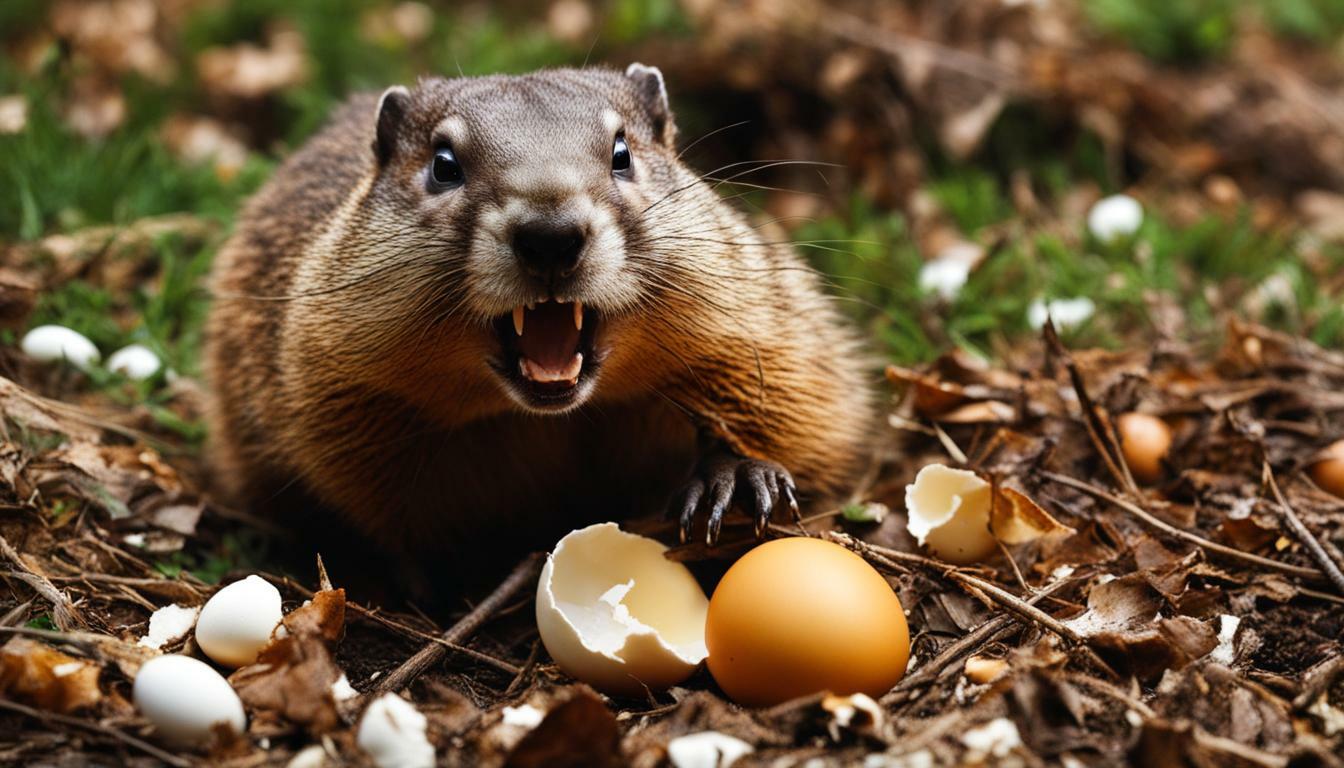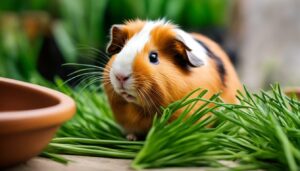Groundhogs, also known as woodchucks, are fascinating creatures with unique eating habits. But do they include eggs in their diet?
Key Takeaways:
- Groundhogs primarily eat plants, grasses, forbs, fruits, and vegetables.
- While groundhogs may occasionally eat small bird’s eggs, they are more interested in chicken feed.
- Groundhogs are not dangerous to chickens and will not directly attack them.
- To prevent groundhog interactions with chickens, keep chicken feed in closed containers and eliminate their habitat near coops.
- Groundhogs occasionally consume insects, small animals, and eggs as part of their scavenging habits.
The groundhog diet primarily consists of grasses, forbs, fruits, and vegetables, making them herbivores by nature.
Understanding the Groundhog Diet
These small mammals have a voracious appetite for plant-based foods, which form the majority of their diet.
Groundhogs are often seen grazing on grass, nibbling on dandelions, and sampling various wildflowers. They also have a particular fondness for fruits such as apples, berries, and melons.
In addition to their love for vegetation, groundhogs may occasionally indulge in other foods. They have been known to consume insects and small animals such as beetles, grasshoppers, caterpillars, crickets, snails, slugs, frogs, toads, mice, birds, and eggs.
However, it’s important to note that these items make up a small portion of their overall diet, and they primarily rely on plant-based foods for sustenance.
To satisfy their nutritional needs, groundhogs actively seek out areas rich in vegetation, such as fields, meadows, and gardens.
They are skilled foragers and use their strong claws and teeth to dig burrows and access underground roots and bulbs.
Table: Common Foods Consumed by Groundhogs
| Food Type | Description |
|---|---|
| Grasses | Includes various types of grass found in their habitat. |
| Forbs | Consists of non-woody flowering plants, such as dandelions and clover. |
| Fruits | Includes apples, berries, melons, and other juicy fruits. |
| Vegetables | Consists of leafy greens, carrots, and other garden vegetables. |
| Insects and Small Animals (occasional) | Includes beetles, grasshoppers, caterpillars, mice, and eggs. |
Understanding the groundhog’s diet is essential for creating a favorable environment for these fascinating creatures.
By providing a variety of plant-based foods and ensuring their access to a suitable habitat, we can help support and coexist with groundhogs peacefully.
Groundhog Feeding Behavior
Groundhogs are known for their foraging habits, as they spend a significant amount of time searching for food in their surroundings.
They have a diverse diet that primarily consists of grasses, forbs, fruits, and vegetables. These herbivorous creatures are not known to eat chicken or chicken eggs, but there have been instances where they may consume small bird’s eggs on occasion.
In addition to their plant-based diet, groundhogs occasionally display scavenging habits by consuming insects and small animals.
They may feast on beetles, grasshoppers, caterpillars, crickets, snails, slugs, frogs, toads, mice, birds, and their eggs.
While these occasional additions to their diet might occur, groundhogs are more interested in obtaining chicken feed than the chickens themselves.
Although groundhogs are not dangerous to chickens and will not directly attack them, their presence near a chicken coop can cause trouble.
Groundhogs are known to dig and forage in the vicinity of coops, potentially disrupting the area and creating difficulties for chicken owners.
To prevent groundhog interactions with chickens, it is recommended to keep chicken feed in closed containers to deter their interest.
Additionally, eliminating groundhog habitats by cutting grass, removing brush or wood piles, using guard animals like dogs or geese, and employing traps as a last resort can be effective preventive measures.
| Groundhog Feeding Behavior | Food Preferences |
|---|---|
| Plants | Grasses, forbs, fruits, vegetables |
| Scavenging Habits | Insects, small animals, beetles, grasshoppers, caterpillars, crickets, snails, slugs, frogs, toads, mice, birds, eggs |
| Interaction with Chickens | Not dangerous, more interested in chicken feed than chickens themselves, may cause trouble by digging and foraging near the coop |
| Prevention Measures | Keep chicken feed in closed containers, eliminate groundhog habitats, use guard animals, employ traps as a last resort |
In conclusion, groundhogs are primarily plant eaters and are not known to eat chicken or chicken eggs.
While they may eat small bird’s eggs on occasion, they are more interested in acquiring chicken feed than harming the chickens themselves.
To prevent groundhogs from causing trouble near chicken coops, it is advised to implement preventive measures such as securing the chicken feed, removing their habitat, and utilizing guard animals or traps if necessary.
Nutritional Requirements of Groundhogs
Groundhogs have specific nutritional requirements to support their overall health and well-being. As primarily herbivorous animals, their diet consists mainly of grasses, forbs, fruits, and vegetables.
They rely on these plant-based foods to meet their essential nutrient needs.
When it comes to their nutritional requirements, groundhogs require a balanced diet that provides them with sufficient amounts of carbohydrates, proteins, vitamins, and minerals.
Carbohydrates, in the form of plant fibers, are crucial for their digestive health and energy production. Proteins are essential for muscle growth and repair.
Vitamins, such as vitamin C and vitamin A, are necessary for their immune system and overall well-being. Minerals like calcium and phosphorus are vital for their bone health.
To ensure groundhogs receive the necessary nutrients, it is important to provide them with a varied diet of fresh grasses, leafy greens, and vegetables.
Some suitable options include dandelion greens, clover, alfalfa, lettuce, and carrot tops. Offering a diversity of plant-based foods will help meet their nutritional requirements and keep them healthy.
| Nutrient | Function | Sources |
|---|---|---|
| Carbohydrates | Energy production | Grasses, forbs, fruits, vegetables |
| Proteins | Muscle growth and repair | Legumes, leafy greens |
| Vitamins | Immune system support | Fruits, leafy greens, vegetables |
| Minerals | Bone health | Calcium-rich foods, leafy greens |
Key Nutrients for Groundhogs
Here are some of the key nutrients that groundhogs require:
- Calcium: Important for healthy bones and teeth. Groundhogs can obtain calcium from leafy green vegetables such as kale and spinach.
- Vitamin C: Essential for immune system functioning. Fruits like apples and oranges are good sources of vitamin C for groundhogs.
- Fiber: Necessary for proper digestion. Grasses and leafy greens provide groundhogs with the fiber they need.
- Protein: Required for muscle development and maintenance. Legumes and leafy greens are good sources of plant-based protein for groundhogs.
By ensuring groundhogs have access to a variety of plant-based foods that meet their nutritional requirements, we can help support their health and well-being.
Groundhogs and Chicken Eggs
While groundhogs are primarily plant eaters, there have been instances where they have been known to consume small bird’s eggs.
However, it is important to note that this behavior is not common and is more of an exception rather than the norm.
Groundhogs typically prioritize a diet consisting of grasses, forbs, fruits, and vegetables.
Groundhogs may occasionally scavenge for eggs, especially those of small birds, when they come across them during their foraging expeditions.
This behavior is likely driven by their innate curiosity and opportunistic nature rather than a dietary requirement.
It is worth mentioning that groundhogs are not known to actively seek out chicken eggs or pose a significant threat to chicken coops.
If you have concerns about groundhogs near your chicken coop, it is essential to focus on their primary food source, which is often chicken feed.
Groundhogs are attracted to the readily available food source and may cause trouble by digging or foraging near the coop.
To prevent groundhogs from getting too close to your chickens, it is advisable to keep chicken feed in closed containers that are inaccessible to groundhogs.
Additionally, trimming grass, removing brush or wood piles, and utilizing guard animals like dogs or geese can help deter groundhogs from entering your property in the first place.
| Groundhog Diet | Groundhog Feeding Behavior | Groundhog Nutritional Requirements |
|---|---|---|
| Grasses | Curiosity-driven scavenging | Adequate plant-based nutrients |
| Forbs | Occasional consumption of small bird’s eggs | Vitamin-rich fruits and vegetables |
| Fruits | Preference for chicken feed | |
| Vegetables |
In conclusion, groundhogs are primarily herbivores with a diet focused on plants, fruits, and vegetables.
While they may occasionally scavenge for small bird’s eggs, their main interest lies in chicken feed rather than attacking chickens directly.
By taking steps to secure chicken feed and deter groundhogs from entering your property, you can minimize any potential interactions between groundhogs and your chickens.
Groundhogs and Chicken Feed
Groundhogs are more interested in getting access to chicken feed than attacking the chickens themselves.
These curious creatures have a penchant for scavenging and foraging, and they often find the scent and taste of chicken feed irresistible.
While they may not directly harm the chickens, their presence near the coop can lead to trouble.
To prevent groundhogs from causing disturbances, it is important to take certain precautions. One effective measure is to keep chicken feed stored in closed containers that are inaccessible to groundhogs.
This ensures that the temptation of the feed does not entice them to dig around the coop or venture too close to the chickens.
Additionally, it is recommended to eliminate potential groundhog habitats by regularly cutting the grass and removing brush or wood piles.
This reduces their hiding places and makes it less likely for them to establish a den near the coop.
Preventing Groundhog Access to Chicken Feed – Tips:
- Keep chicken feed in closed containers or barns, away from the reach of groundhogs.
- Cut the grass around the coop regularly to deter groundhogs from establishing a den nearby.
- Remove any brush or wood piles that may serve as hiding places for groundhogs.
- Consider using guard animals, such as dogs or geese, to deter groundhogs from approaching the coop.
- If all else fails, traps can be used as a last resort to capture and relocate groundhogs.
By implementing these preventive measures, you can minimize the likelihood of groundhogs causing trouble near your chickens.
Remember that groundhogs primarily seek out chicken feed rather than direct confrontation with the birds.
By securing the feed and eliminating their habitat, you can create a safer environment for your chickens while coexisting with these curious creatures.
| Groundhog Diet | Groundhog Feeding Behavior |
|---|---|
| Grasses | Scavenging habits |
| Forbs | Foraging near coops |
| Fruits | Digging behavior |
| Vegetables | Eating chicken feed |
In addition to their interest in chicken feed, groundhogs occasionally consume insects and small animals, including beetles, grasshoppers, caterpillars, crickets, snails, slugs, frogs, toads, mice, birds, and eggs.
However, their diet primarily consists of grasses, forbs, fruits, and vegetables. While they may occasionally eat small bird’s eggs, they are not known to regularly consume chicken eggs.
To summarize, groundhogs are more inclined to seek out chicken feed than attack chickens. They can be deterred by securing the feed and eliminating potential habitats near the coop.
By implementing these preventive measures, you can protect your chickens while coexisting with these curious and resourceful creatures.
| Eat | Don’t Eat |
|---|---|
| Chicken feed | Chicken eggs |
| Grasses | Chickens |
| Forbs | Chicken coop |
| Fruits | |
| Vegetables |
Preventing Groundhog Interactions with Chickens
To minimize the interaction between groundhogs and chickens, certain measures can be taken to deter groundhogs from coming near the coop.
Groundhogs are primarily plant eaters and are not known to eat chicken or chicken eggs. However, they may be attracted to the chicken feed and cause trouble by digging and foraging near the coop.
Here are some effective strategies to prevent groundhog interactions with chickens:
- Secure Chicken Feed: Keep chicken feed in closed containers to prevent groundhogs from accessing it. Groundhogs are more interested in the feed than the chickens themselves, so removing their food source can discourage their presence near the coop.
. - Eliminate Habitat: Cut the grass around the coop and remove brush or wood piles, as these provide hiding spots for groundhogs. By eliminating their habitat, you can reduce the likelihood of groundhogs setting up residence near the chickens.
. - Use Guard Animals: Consider keeping guard animals like dogs or geese near the coop. These animals can help deter groundhogs and other potential predators from approaching the chickens.
. - Trapping: Use traps as a last resort if other methods are ineffective or if groundhogs become a persistent problem. Consult local regulations and guidelines for proper trapping techniques and ensure the humane relocation of captured groundhogs.
Groundhog Scavenging Habits
While groundhogs are primarily plant eaters, they occasionally consume insects and small animals, including beetles, grasshoppers, caterpillars, crickets, snails, slugs, frogs, toads, mice, birds, and eggs. However, their diet primarily consists of grasses, forbs, fruits, and vegetables.
By implementing these preventive measures, you can create a safer environment for your chickens and minimize any potential interactions with groundhogs.
Remember, it’s important to provide a secure and stress-free space for your feathered friends!
| Groundhog Food Habits | Groundhog Foraging Habits |
|---|---|
| Primarily plant eaters | Search for food close to their burrows |
| Occasionally scavenge insects and small animals | Dig for roots and tubers |
| Preference for grasses, forbs, fruits, and vegetables | Forage during early morning and late afternoon |
Groundhogs’ Scavenging Habits
While groundhogs primarily stick to a plant-based diet, they may occasionally scavenge for insects, small animals, and eggs.
Although their main source of nutrition comes from grasses, forbs, fruits, and vegetables, groundhogs have been known to opportunistically consume a variety of other food sources.
When it comes to scavenging, groundhogs are not picky eaters. They have been observed munching on beetles, grasshoppers, caterpillars, crickets, snails, slugs, frogs, toads, and even small mammals like mice and birds.
In some cases, groundhogs have been known to raid bird nests and consume eggs, including those of small songbirds.
It’s important to note that while groundhogs may occasionally scavenge for eggs, they are not a significant cause for concern when it comes to chicken coops.
Groundhogs are more interested in accessing chicken feed than the chickens themselves. By taking measures to secure chicken feed in closed containers and eliminating groundhogs’ habitat near the coop, you can effectively prevent unwanted interactions between groundhogs and your feathered friends.
| Scavenged Food | Frequency |
|---|---|
| Insects | Occasionally |
| Small Animals | Occasionally |
| Eggs | Occasionally |
While groundhogs may occasionally scavenge for small animals and eggs, their primary diet consists of plant-based materials.
By understanding the scavenging habits of groundhogs and implementing suitable preventive measures, you can ensure a harmonious coexistence between groundhogs and your backyard chickens.
Groundhog’s Impact on Chickens
Groundhogs can cause trouble for chickens by digging near the coop, foraging for food, or consuming chicken feed.
Although groundhogs are primarily plant eaters and not known to eat chicken or chicken eggs, they may occasionally eat small bird’s eggs.
However, their main interest lies in accessing chicken feed rather than the chickens themselves. While they are not inherently dangerous to chickens and do not directly attack them, their actions can disrupt the environment around the coop and potentially lead to issues.
To mitigate the impact of groundhogs on chickens, there are several preventive measures you can take.
First and foremost, it is recommended to keep chicken feed in closed containers to ensure groundhogs cannot access it.
Removing their habitat by cutting the grass, eliminating brush or wood piles, and sealing off potential entry points can discourage groundhogs from coming near the coop.
Additionally, employing guard animals like dogs or geese can help deter groundhogs, as they are wary of other animals.
If all else fails, traps can be used as a last resort to capture and relocate groundhogs away from the chicken area.
Groundhogs’ Scavenging Habits
While groundhogs primarily rely on plant-based diets, it’s important to note their occasional scavenging habits.
Alongside a diet of grasses, forbs, fruits, and vegetables, they may also consume insects, small animals, and eggs.
This scavenging behavior can include feeding on beetles, grasshoppers, caterpillars, crickets, snails, slugs, frogs, toads, mice, birds, and their eggs.
However, it is crucial to reiterate that groundhogs’ preference for these items is relatively rare compared to their plant-based diet.
| Groundhog Diet | Other Scavenged Items |
|---|---|
| Grasses | Beetles |
| Forbs | Grasshoppers |
| Fruits | Caterpillars |
| Vegetables | Crickets |
| Snails | |
| Slugs | |
| Frogs | |
| Toads | |
| Mice | |
| Birds | |
| Eggs |
By understanding the feeding behavior and preferences of groundhogs, you can better protect your chickens from potential disruptions while maintaining a safe and harmonious environment for all.
Conclusion
While groundhogs are primarily herbivores, they may occasionally consume small bird’s eggs. However, their focus is more on accessing chicken feed than directly attacking chickens or their eggs.
Groundhogs are not dangerous to chickens, but they can cause trouble by digging around the coop or eating chicken feed.
To prevent groundhog interactions with chickens, it is recommended to keep chicken feed in closed containers and eliminate their habitat by cutting grass and removing brush or wood piles.
Using guard animals like dogs or geese can also help deter groundhogs. Traps should only be used as a last resort, as they may cause harm to the groundhog or other unintended wildlife.
It is important to remember that groundhogs occasionally eat insects and small animals, including beetles, grasshoppers, caterpillars, crickets, snails, slugs, frogs, toads, mice, birds, and eggs.
Their diet primarily consists of grasses, forbs, fruits, and vegetables.
By implementing preventative measures and understanding the feeding habits of groundhogs, you can minimize any potential conflicts between groundhogs and chickens.
Remember to secure your chicken feed, create a less inviting habitat for groundhogs, and consider utilizing guard animals to protect your chickens.
With these strategies in place, you can coexist peacefully with groundhogs while ensuring the wellbeing of your chickens.
FAQ
Do groundhogs eat chicken or chicken eggs?
Groundhogs are primarily plant eaters and are not known to eat chicken or chicken eggs. While they may occasionally eat small bird’s eggs, they are more interested in getting at chicken feed than the chickens themselves.
What do groundhogs eat?
Groundhogs primarily eat grasses, forbs, fruits, and vegetables. They occasionally consume insects and small animals such as beetles, grasshoppers, caterpillars, crickets, snails, slugs, frogs, toads, mice, birds, and eggs.
Are groundhogs dangerous to chickens?
Groundhogs are not dangerous to chickens and will not attack them directly. However, they may cause trouble by digging and foraging near the coop or eating chicken feed.
How can I prevent groundhogs from getting near my chickens?
To prevent groundhogs from getting near chickens, it is recommended to keep chicken feed in closed containers, eliminate their habitat by cutting grass and removing brush or wood piles, use guard animals like dogs or geese, and use traps as a last resort.
What are the nutritional requirements of groundhogs?
Groundhogs have specific nutritional requirements and need a diet that includes a variety of plant-based foods for optimal health.
Do groundhogs consume chicken eggs?
While groundhogs may occasionally eat small bird’s eggs, they are not known to consume chicken eggs as a primary part of their diet.
Can groundhogs cause trouble near chicken coops?
Groundhogs can cause trouble near chicken coops by digging and foraging near the coop or eating chicken feed. However, they are not known to directly attack or harm chickens.
How can I prevent groundhog interactions with chickens?
To prevent groundhog interactions with chickens, it is important to take steps such as keeping chicken feed in closed containers, eliminating groundhog habitats, using guard animals, and using traps as a last resort.
What are groundhogs’ scavenging habits?
Groundhogs occasionally scavenge for food and may consume insects, small animals, and eggs as part of their diet.
What impact can groundhogs have on chickens?
Groundhogs can cause trouble near chicken coops by digging, foraging, and eating chicken feed. However, they are not known to directly harm or attack chickens.




